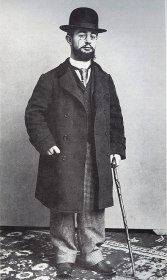  Henri de Toulouse-Lautrec was a French painter, printmaker, caricaturist and illustrator whose embrace of the colourful life of Paris in the late 19th century allowed him to produce a collection of enticing and provocative images of the often decadent entertainment of the time.
Henri de Toulouse-Lautrec was a French painter, printmaker, caricaturist and illustrator whose embrace of the colourful life of Paris in the late 19th century allowed him to produce a collection of enticing and provocative images of the often decadent entertainment of the time.Toulouse-Lautrec was the first artist to elevate advertising to the status of fine art. This was an extraordinary shift, removing the boundaries between sophisticated art (painting, drawing, sculpture) and commercial art (posters, logos, signs). Accepting that some of his greatest masterpieces were posters for nightclubs does not in any way diminish their value.  Born into aristocracy, Toulouse-Lautrec broke both his legs around the time of his adolescence and, possibly due to the rare condition pycnodysostosis, was very short as an adult due to his undersized legs.
Born into aristocracy, Toulouse-Lautrec broke both his legs around the time of his adolescence and, possibly due to the rare condition pycnodysostosis, was very short as an adult due to his undersized legs.Toulouse-Lautrec's parents were first cousins, and his condition has often been attributed to a family history of inbreeding. Toulouse-Lautrec's legs ceased to grow when he reached 5 feet in height; he developed an adult torso while retaining his child-sized legs. Toulouse-Lautrec turned his disability into an advantage. At a time when persons with disabilities were relegated to freak shows, he made good use of his unique appearance. As an artist, it allowed him to disappear into a crowd or the corners of a room, seeing others without being seen.  Toulouse-Lautrec's posters, prints, and paintings made him an informal historian of urban life in late 1800's Paris, as portrayed in the film 'Moulin Rouge'. His remarkable observations of people on the margins of society almost certainly stems from his status as an outsider.
Toulouse-Lautrec's posters, prints, and paintings made him an informal historian of urban life in late 1800's Paris, as portrayed in the film 'Moulin Rouge'. His remarkable observations of people on the margins of society almost certainly stems from his status as an outsider. The singers, dancers, acrobats, and prostitutes with whom he socialized became his family. He identified with them. In contrast to nearly all other artists at the time, Toulouse-Lautrec had no trouble making a living. He essentially worked for the entertainment business, where selling drinks and tickets was the bottom line. His posters were in big demand. Toulouse-Lautrec inevitably suffered from alcoholism. He also developed an affinity for brothels and prostitutes that led to him contracting syphilis. However, this lifestyle certainly directed the subject matter for many of his works, which record details of the late-19th-century bohemian lifestyle in Paris. He is among the painters described as being Post-Impressionists, along with with Paul CÚzanne, Vincent van Gogh, Georges Seurat, and Paul Gauguin. In his short 20-year art career, Toulouse-Lautrec was exceptionally prolific, creating 737 canvases, 275 watercolours, 363 prints and posters, and at least 5,084 drawings - as well as ceramic and stained glass work. Lautrec is believed to have contracted syphilis at age 22, apparently from the prostitute Rosa La Rouge, who appears in several of his paintings. Towards the end of his life, Lautrec suffered from paranoia and hallucinations as a result of his chronic alcohol abuse and syphilis. Henri's alcoholism and wild lifestyle finally caught up with him when in 1889 he was placed in a sanitorium after a particularly violent bout of delerium tremens. He recovered and was released, but died in 1901 from complications due to alcoholism and syphilis at the age of 34. Have a look at some of the amazing art of Henri de Toulouse-Lautrec:
|